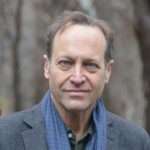
Public art installation offers unusual imagery for an inauguration without precedent
Transcript
Notice: Transcripts are machine and human generated and lightly edited for accuracy. They may contain errors.
Judy Woodruff: As we have seen, today’s inauguration featured unusual imagery, a response to the unusual circumstances.
The temporary public art is intended to represent the American people and to unify the country.
Jeffrey Brown has our look.
It’s part of our arts and culture series, Canvas.
Jeffrey Brown: In the sky above Washington, pillars of light, 56 in all, symbolizing the 50 states, the District of Columbia and five U.S. territories.
On the ground, a field of flags, nearly 200,000 of them, representing the millions of people unable to attend due to pandemic and ramped-up security measures, an inauguration without precedent, imagery to match.
Adam Baron: This is something that is meant to be evocative for everybody.
Jeffrey Brown: Adam Baron, deputy director of events for the Presidential Inaugural Committee, helped create and oversee the installations, American flags of all sizes, flags of the states and territories.
Baron says the idea grew from looking at past inauguration scenes.
Adam Baron: When you look down the Mall, it’s not just the people that you see. There are just these thousands of waving American flags that represent people from all stripes coming together to celebrate a new administration.
So, we sort of took that image, and we wanted to have those waving flags represent people that could not safely or smartly come together and gather this year.
Jeffrey Brown: So, the imagery is really from inaugurations past, but without the people, in a sense.
Adam Baron: Yes.
We knew we had to do something that was still celebratory to commemorate the importance of the moment, but that was smart and thoughtful of the health and safety of everybody involved.
Jeffrey Brown: Of course, the intended audience was, as with so much now remote, public art on public space now closed to the public, and not just any space, but the National Mall, home to enduring symbols of American democratic values.
Philip Kennicott is a Pulitzer Prize-winning critic for The Washington Post.
Philip Kennicott: In Washington, we’re just two weeks out from having seen a violent mob storm the Capitol. What we see here is, in a sense, a kind of fantasy of the crowd, as orderly, as collective, as gathering in proximity, but in a constructive way.
Jeffrey Brown: Constructive, yet different for this very different moment.
Kennicott points to the evocative shafts of lights that once illuminated the absent World Trade Center Twin Towers after 9/11, or the rows of orderly flags familiar at cemeteries or battlefields. Those evoke sorrow. These images, he thinks, might offer something more hopeful.
Philip Kennicott: By using the National Mall in this way, they’re inviting us not just to sort of be spectators, but to kind of project ourselves into that crowd and feel as somehow we’re more than just passive participants in this.
Jeffrey Brown: You’re saying we, as citizens, need to find a new way to connect to public spaces, to public events, to politics itself. What role does the art play?
Philip Kennicott: In some ways, that’s an effort to get us to go beyond the fairly passive and reactive role that we have taken up with democracy through things like social media, through television, and actually get out there and do something, be physically present.
We can’t do that at the moment. But this is making us, in a way, yearn to be in that space a little more tangibly than we might if we just watched it on television, as we used to do.
Jeffrey Brown: That asks a lot of what is, after all, a temporary art installation.
But we’re a country in need of a lot just now.
For the “PBS NewsHour,” I’m Jeffrey Brown.
Support Canvas
Sustain our coverage of culture, arts and literature.

















